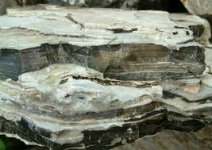mamabear
Silver Member
I have some flint from WYO, & S.D. I also have a lot of agate. The flint I have looks a lot like agate, especially moss agate. So my understanding is flint is sedimentary & agate is metamorphic. Is this correct? It's hard for me to fathom 2 rocks that look so much a like have such different origins. Is there a common mineral composite that makes them appear so alike?







